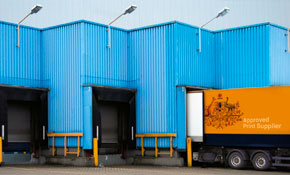
Print procurement is big business, and buyers don’t come much bigger than the Federal government. So when Canberra announced it was streamlining its print procurement, the industry sat up and listened. The arrangement started as a $220m pool of work across a dozen government departments. Within months it had snowballed, taking in another five agencies, with more sure to follow.
The idea of approved supplier lists is not new. And neither is the government’s move to a more streamlined approach. There’s a wider overhaul going on right across government. Service delivery reform across social, health and welfare services aims to “dramatically enhance its flexibility and effectiveness” and cut red tape. Under the banner ‘Works For You’, the reform is led by human service minister Chris Bowen. It’ll see Medicare, Centrelink and the Child Support Agency “operating as one” following legislation due to be passed in 2011.
While neither the Works For You reform nor the ‘Design, Production and Distribution Tender Program’ are necessarily being sold as purely cost-saving drives spurred on by the GFC, both seem symptomatic of the current climate.
“The reality of the current fiscal environment is that we have to look at every aspect of our base to reduce cost and streamline our operations. This trend in print distribution contracts is just a manifestation of that,” said Hank Jongen, general manager of Centrelink and the driving force behind the print procurement shake-up.
The economies of scale offered by bringing together the buying clout of multiple Federal agencies is clear. “Look at the scope of the agencies that are now involved,” said Jongen. “Centrelink is a big purchaser of print. We deal with 6.5 million customers.”
He reckons that if you bring Medicare under that same umbrella, “you’re talking virtually the whole population”.
There are some phenomenal individual print jobs brought to the table by the agencies currently signed up. The Bureau of Statistics brings the Census. The ATO puts out a tax pack every year. The Electoral Office runs the Federal election.
“The Federal government is a huge procurer of print. I’d be surprised if there were a bigger print procurer than us,” added Jongen.
But it’s not just about capitalising on the economies of scale, he said. “It’s about streamlining and simplifying the way in which we buy print services.”
The mantle has fallen to Centrelink to put this into practice. “As a major print procurer, Centrelink formulated a model that put us in a very strong position and we were then able to convince the rest of government to put their trust in us and enable us to pull together an unprecedented program in engaging the print industry,” added Jongen.
The next step
He sees this latest development as just the next step on an evolution in the way government procures outside services. “When I was first involved in this game, a lot of our printing was done in-house. Then some years ago there was a big push for government to outsource what wasn’t considered as core business.
“I certainly formed the conclusion that this was not core business for us. So we went down the track of forging partnership for a whole swag of services in this space. Not just printing but also things such as warehousing and distribution.”
The Centrelink model has – up until now – been intrinsically linked to Stream Solutions, which had managed the agency’s print spend. One of the big changes is that Stream will no longer be Centrelink’s sole PM supplier (though the company will continue to manage Centrelink’s print under an interim set-up until May, after which the new regime kicks in).
Stream is one of four companies on the Print Management category of the panel, along with Rothfield Print & Image, Ergo Asia and Foxprint Solutions. Essentially, all four of them could bid to become the print manager of choice to any of the listed government agencies. The winning print manager would still be required to source from the pool of printers on the Print & Production panel.
And that’s not necessarily a better deal for printers, said Stream managing director Andrew Price. He told ProPrint that Stream’s approved suppliers number around the 400 mark. “They’ve gone from a panel of 400 odd printers down to 80 or 90. That’s going to have a massive impact on the industry. It’ll have an impact, but I don’t know whether it’ll deliver better prices or not.”
Of course, Jongen believes the strategy will save on government’s print spend – and not just from a whole government point of view, but specifically for his department too.
“If you look at it from a Centrelink perspective, the more other agencies we get on board, the more economies of scale we get. Even from my own budget perspective, it drives down prices,” said Jongen.
There are other criticisms from printers, but support too. ProPrint spoke to a number of printers on the approved supplier list. One printer, who asked not to be named, has extensive experience working for government, including being an approved supplier for the ATO and Medicare in the past.
“[The new strategy] has a lot of advantages in that it reduces the number of tenders you have to do. Tenders are so time-consuming. Predominantly the information you put in is the same, but a lot of them are set up in different ways so you have to rearrange it to suit the circumstances,” he said.
Industry criticism
However, he wasn’t all compliments. This unnamed source said he expected work would still slip through the gaps in the system. Jobs could still go to the market in ways other than via the approved channels, he said. “It’d be interesting to find out the leakage. It’s all very well to say everybody is putting their print quotes through this but I can guarantee you they’re not. Some will find it too cumbersome.”
Jongen disagreed with this assumption. He said that internal protocols and communicating the strategy internally would stop work from leaking out.
“It would also put us in breach of contract to go outside of those arrangements. And that’s made clear to those delegates who exercise authority in their departments,” he said.
“In other words, it’s effectively illegal to go outside these contracts,” added Jongen.
Another criticism levelled at the strategy is geographic. The panel includes printers all across the country, but surely it’ll make sense for the vast majority of work to be produced in Canberra?
Award-winning Brisbane firm Platypus Graphics is on the approved supplier list. Director Tom Lusch said he thought about 80% of the Federal government’s work was swallowed up in Canberra.
“I don’t know that that’s a freight issue – I think it’s more of a relationship issue. [The printers down there] obviously have better rapport than what we have 1,200 kilometres away.”
But isn’t it all about price? The unnamed printer told ProPrint that while he thought it was good the panel had been opened up to SMEs and regional printers, “the government tendering process is extremely price-competitive”.
“They’re using all the genuine credentials in terms of capability, ISO certifications, quality and service reliability – if all the printers they have approved meet those categories, it all comes down to price,” said the printer.
Good for printers?
This new strategy might be about helping the government “reduce cost due the fiscal environment”, but Jongen is adamant it’s going to be a benefit to print suppliers too.
“I’ve always been very concerned about the protection of the industry as a whole. From my point of view, it’s really good that our approach allows a level playing field where small to medium enterprises can compete for work with larger players. In fact, about 90% of the players in the current arrangement are SMEs. That’s a matter with which I take great personal satisfaction,” he said.
But what about the fact that only 86 printers have made it onto the list? It’s a case of ‘better luck next time’ – the Print & Production panel will be renewed this October, then every year for the next four years.
“When the multi-use list is refreshed, it will be thrown open to potential suppliers via the same transparent tender process that populated the first lists,” said Jongen.
“Well that’s fine,” said Stream’s Price, “but when the industry’s in the biggest crunch time ever right now, this could spell disaster for a lot of small businesses.”
Comment below to have your say on this story.
If you have a news story or tip-off, get in touch at editorial@sprinter.com.au.
Sign up to the Sprinter newsletter


